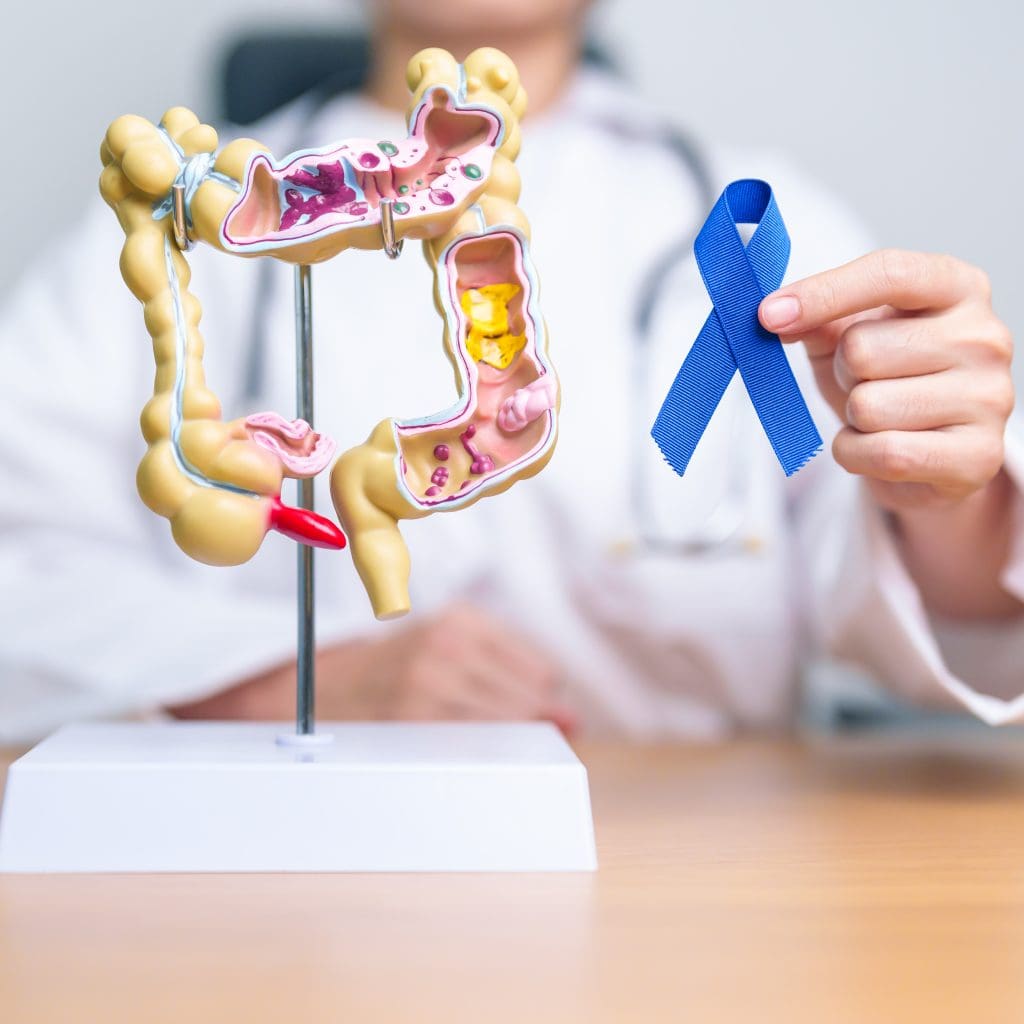Last Updated on November 27, 2025 by Bilal Hasdemir
Does Colon Cancer Hurt? Many people with colon cancer feel abdominal pain first. This pain can be mild or very uncomfortable. It makes people worry about how serious the disease is and how it affects their daily life.
The link between colon cramping and colon cancer is not simple. Sometimes, pain is the first sign of the disease. It’s important to know if the pain is from bowel obstruction pain or constipation pain. This helps both patients and doctors understand the situation better.
Key Takeaways
- Colon cancer often presents with abdominal pain as a primary symptom.
- The pain can range from mild cramping to severe discomfort.
- Understanding the nature of colon cancer pain is key for diagnosis and treatment.
- Bowel obstruction and constipation can cause pain in patients.
- Spotting colon cancer symptoms early can lead to better treatment results.
Understanding Colon Cancer and Its Symptoms

It’s important to know the symptoms of colon cancer to get medical help early. Colon cancer starts in the colon or rectum. It can show itself in different ways.
What is Colon Cancer?
Colon cancer is a cancer in the large intestine (colon). It often begins as small, non-cancerous clumps called polyps. These can turn into cancer over time. The American Cancer Society says it’s a common cancer in the U.S. for both men and women.
Common Symptoms Beyond Pain
Pain is a symptom of colon cancer, but there are others to watch for. These include:
- Changes in bowel movements, such as diarrhea or constipation
- Blood in the stool or black, tarry stools
- Unexplained weight loss
- Fatigue or weakness
- Loss of appetite
A study in the NCBI Bookshelf shows how important cachexia is in advanced cancer. Cachexia causes weight loss, muscle shrinkage, and tiredness.
“Cachexia is a multifactorial syndrome defined by an ongoing loss of skeletal muscle mass (with or without loss of fat mass) that cannot be fully reversed by conventional nutritional support and leads to progressive functional impairment.”
When to Seek Medical Attention
If you notice any of these symptoms, you should see a doctor:
| Symptom | Description |
| Persistent rectal bleeding | Bleeding that keeps going or is with pain or changes in bowel habits. |
| Changes in bowel habits | Diarrhea, constipation, or narrow stools for more than a few days. |
| Unexplained weight loss | Weight loss without a clear reason, which might mean advanced disease. |
Early detection and treatment of colon cancer can greatly improve survival chances. Knowing the symptoms and risk factors is key to staying healthy.
Colon Cancer Pain: Types and Characteristics
It’s important to know about colon cancer pain for both patients and doctors. Colon cancer can cause different kinds of pain. It’s key to tell these pains apart from other stomach issues.
Is Pain Common in Colon Cancer?
Many people with colon cancer feel pain. Research shows that a lot of them have pain, which can be different in each person. The pain’s type and how bad it is can depend on the tumor’s size and where it is.
- Early-stage colon cancer might not hurt, so getting checked early is important.
- As cancer grows, pain often gets worse and lasts longer.
- Pain can happen if the tumor blocks the colon or presses on other areas.
How Colon Cancer Pain Feels
Colon cancer pain can feel different. Here are some common ways it’s described:
- Cramping or cramp-like sensations in the belly, feeling like bad menstrual cramps or gas.
- Rectal pain or discomfort, if the tumor is in the lower colon or rectum.
- A feeling of painful bloating or discomfort that doesn’t go away.
- Tumor pressure pain, feeling like a dull ache or sharp pain, based on the tumor’s size and where it is.
Distinguishing Colon Cancer Pain from Other Digestive Issues
It can be hard to tell colon cancer pain from other stomach problems because they share symptoms. But, there are clues that can help spot colon cancer pain:
- Pain that keeps getting worse or doesn’t go away, unlike pain that comes and goes or is tied to food.
- Pain with other signs like losing weight, changes in bowel movements, or blood in the stool.
- Pain in one spot, which might match where the tumor is.
Knowing these signs can help find colon cancer early and treat it right. If you have ongoing or severe belly pain, see a doctor to figure out why.
Early Stage Colon Cancer: Is Pain Present?
Knowing if early colon cancer hurts can help find and treat it early. Catching it early can greatly improve treatment success and survival rates.
Pain Symptoms in Stage 1 and 2
In the early stages, like Stage 1 and 2, pain might not be a big sign. But, some people might feel mild discomforts that could mean something’s wrong.
Pain symptoms can be different, like mild belly pain or changes in how often you go to the bathroom. It’s key to notice these signs early to get medical help fast.
Why Early-Stage Cancer May Be Painless
Early colon cancer might not hurt because the tumor is small. It hasn’t grown into the tissues or nerves yet, which are where pain usually comes from. Knowing this helps patients watch for other signs.
Other Early Warning Signs to Watch For
There are other signs of colon cancer to look out for, aside from pain. These include:
- Changes in bowel habits, such as diarrhea or constipation
- Blood in the stool or black, tarry stools
- Unexplained weight loss
- Fatigue or weakness
Staying alert to these symptoms can lead to catching colon cancer early. This can greatly improve colon cancer survival rates.
| Early Warning Signs | Description |
| Changes in Bowel Habits | Diarrhea, constipation, or a feeling that the bowel does not empty completely |
| Blood in Stool | Visible blood or black, tarry stools |
| Unexplained Weight Loss | Losing weight without a clear reason |
Spotting the early signs of colon cancer and knowing its stages is key to effective treatment. It’s vital for those at risk to know these signs and see a doctor if they notice anything unusual.
Abdominal Pain in Colon Cancer
Understanding abdominal pain is key to spotting colon cancer. It can show up in different ways and places. Each person’s pain is unique, making it hard to diagnose.
Colon cancer pain can happen anywhere in the abdomen. It depends on where and how big the tumor is. The pain’s type and strength can tell us a lot about the disease.
Left Side Abdominal Pain
Pain on the left side might mean colon cancer, if the tumor is in the descending or sigmoid colon. You might also notice changes in your bowel habits or see blood in your stool. It’s important to see a doctor if the pain doesn’t go away or gets worse.
Right Side Abdominal Pain
Pain on the right side can also point to colon cancer, if the tumor is in the ascending colon. This pain might be mistaken for appendicitis or other issues. As one doctor says,
“The location of the tumor within the colon can significantly influence the presentation of abdominal pain.”
Lower Belly Pain Patterns
Pain in the lower belly, or suprapubic pain, can happen with colon cancer, if the tumor is near the rectum or sigmoid colon. You might feel like you can’t fully empty your bowels or like your rectum is full. Knowing these patterns can help catch the disease early.
In summary, colon cancer pain can show up in many ways, based on the tumor’s location and your health. Spotting these patterns and getting medical help quickly are vital for managing the disease.
Specific Pain Symptoms Associated with Colon Cancer
It’s important to know the pain symptoms of colon cancer for early detection. Colon cancer can cause different types of pain. Each type can help identify the disease.
Cramping and Persistent Cramps
Cramping is a common pain symptom of colon cancer. These cramps can be severe and last a long time. They might feel like bad menstrual cramps or digestive issues.
The cramping happens when the tumor blocks the colon or presses on nearby tissues.
Gas Pain and Bloating
Gas pain and bloating can also be symptoms of colon cancer. The tumor can block part of the colon. This leads to gas buildup and discomfort or pain.
This symptom can be mistaken for other digestive problems. So, it’s key to see a doctor if it doesn’t go away.
Pain During Bowel Movements
Pain during bowel movements is another sign of colon cancer. A tumor can narrow or block the colon. This makes bowel movements painful.
If the tumor is near the rectum, it can cause pain or discomfort when you have to go.
In summary, knowing these pain symptoms can help find colon cancer early. If you have persistent cramping, gas pain, bloating, or pain during bowel movements, see a doctor. They can check and diagnose you properly.
Complications of Colon Cancer That Cause Pain
Colon cancer complications can lead to painful symptoms that need immediate medical attention. As the disease progresses, various issues can arise. These affect the patient’s quality of life and overall well-being.
Bowel Obstruction Pain
Bowel obstruction is a serious complication of colon cancer. It occurs when the tumor blocks the intestine. This blockage can cause severe abdominal pain, nausea, vomiting, and constipation.
The pain from bowel obstruction can be crampy and intermittent. It often worsens after eating.
Symptoms of bowel obstruction pain may include:
- Severe stomach cramps
- Abdominal distension
- Vomiting
- Constipation or obstipation
Colon Perforation Pain
Colon perforation is another complication of colon cancer. It occurs when the tumor creates a hole in the colon wall. This can lead to peritonitis, an infection of the abdominal cavity, causing severe pain and potentially life-threatening consequences.
The pain from colon perforation is typically sudden and severe. It is often accompanied by:
- Severe abdominal tenderness
- Fever
- Nausea and vomiting
- Abdominal rigidity
Tumor Pressure Pain
As colon tumors grow, they can exert pressure on surrounding tissues and organs. This leads to pain. The nature and location of the pain depend on the tumor’s size and position.
Tumor pressure pain can manifest as:
- Dull, aching pain in the abdomen
- Pain radiating to the back or pelvis
- Discomfort during bowel movements
The following table summarizes the complications of colon cancer and their associated pain characteristics:
| Complication | Pain Characteristics | Associated Symptoms |
| Bowel Obstruction | Crampy, intermittent pain | Nausea, vomiting, constipation |
| Colon Perforation | Sudden, severe pain | Fever, abdominal tenderness, nausea |
| Tumor Pressure | Dull, aching pain | Pain radiating to back or pelvis, discomfort during bowel movements |
Advanced Colon Cancer Pain Symptoms
When colon cancer gets worse, it can cause more pain. This pain is often because the cancer has spread to other parts of the body. Patients may feel different types of pain that can really hurt their quality of life.
Pain Related to Cancer Spread
Colon cancer spreading can cause pain in many parts of the body. The pain’s type and how bad it is can change based on where and how much the cancer has spread. Cancer spread abdominal pain is common, as the cancer often goes to nearby organs in the belly.
Liver Metastasis Pain
The liver is a common place for colon cancer to spread to. Liver metastasis pain can feel like discomfort or pain in the upper right belly. It might also spread to the back or right shoulder. This pain usually happens because the liver gets bigger or the liver capsule gets involved.
Bone Metastasis Pain
Colon cancer can also spread to bones, causing bone metastasis pain. This pain is usually in the bone it affects and can get worse with movement or pressure. Bones like the spine, hips, and ribs are common places for this to happen.
It’s important to know why and how pain happens in advanced colon cancer. By understanding the pain from cancer spread, liver, and bone metastasis, doctors can make better plans to help patients feel better.
Diagnosing the Cause of Colon Pain
Diagnosing colon cancer involves a series of tests and procedures. These help find the cause of colon pain. Accurate diagnosis is key for effective treatment.
Diagnostic Tests and Procedures
Several tests and procedures are used to identify colon cancer. These include:
- Colonoscopy: A procedure that allows doctors to visually examine the inside of the colon for polyps or tumors.
- Biopsy: A sample of tissue is taken during a colonoscopy for further examination.
- Imaging tests: CT scans, MRI, and PET scans help determine the extent of cancer spread.
- Blood tests: Tests like the carcinoembryonic antigen (CEA) test can help monitor cancer markers.
Early detection through these tests can significantly improve treatment outcomes.
Differentiating Cancer Pain from Other Conditions
Colon pain can be caused by various conditions, not just colon cancer. It’s important to find the exact cause.
Conditions that may cause similar pain include irritable bowel syndrome (IBS), diverticulitis, and inflammatory bowel disease (IBD).
A thorough medical history and diagnostic tests help differentiate these conditions.
The Importance of Timely Diagnosis
Timely diagnosis is critical for effective colon cancer treatment. Delayed diagnosis can lead to cancer progression, making treatment more challenging.
“Early detection and treatment of colon cancer can significantly improve survival rates and quality of life.”
So, it’s important to seek medical attention if persistent colon pain or other symptoms occur.
Treatment Options for Colon Cancer
It’s important for patients and their families to know about colon cancer treatments. The right treatment depends on the cancer’s stage, the patient’s health, and other factors.
Surgery and Its Impact on Pain
Surgery is a key treatment for colon cancer. It aims to remove the tumor and affected colon parts. Surgical resection can help get rid of the cancer, which may reduce or stop pain.
The surgery type varies based on the cancer’s location and stage. For early-stage cancer, a minimally invasive surgery might be chosen. This can lead to quicker recovery and less pain after surgery.
Chemotherapy and Radiation
Chemotherapy uses drugs to kill cancer cells. It’s often used after surgery to get rid of any remaining cancer. Chemotherapy can be taken orally or through an IV.
Radiation therapy uses high-energy rays to kill cancer cells. It’s used for cancer that has spread to other areas, like the liver or pelvis. This helps control symptoms and pain.
Targeted Therapies
Targeted therapy uses drugs to target specific cancer cell mechanisms. It’s often used with chemotherapy for advanced colon cancer.
| Treatment Option | Description | Impact on Pain |
| Surgery | Removal of tumor and affected colon part | Can reduce or eliminate cancer-related pain |
| Chemotherapy | Drugs to kill cancer cells | Can reduce pain by shrinking tumors |
| Radiation Therapy | High-energy rays to kill cancer cells | Can control symptoms and pain in advanced cancer |
| Targeted Therapy | Drugs targeting specific cancer mechanisms | Can help manage pain by reducing tumor size |
Managing Colon Cancer Pain
Managing colon cancer pain is key to improving life quality for patients. This pain can greatly affect a patient’s well-being. So, it’s important to have good pain management plans.
Pain Relief Medications
Pain meds are vital for managing colon cancer pain. The choice of medication depends on the pain’s severity and the patient’s health. Non-opioid analgesics are good for mild to moderate pain. For more severe pain, opioids might be needed.
It’s important for patients to work with their doctors to find the right medication. They should also watch for any side effects.
Non-Pharmaceutical Approaches to Pain Management
There are also non-medical ways to manage colon cancer pain. Physical therapy, acupuncture, and cognitive-behavioral therapy can help. These methods can reduce pain and improve life quality.
- Physical therapy can help improve mobility and reduce pain.
- Acupuncture involves inserting thin needles into specific points on the body to alleviate pain.
- Cognitive-behavioral therapy can help patients develop coping strategies for managing pain.
Palliative Care for Advanced Cancer Pain
Palliative care focuses on relieving symptoms and stress of serious illnesses like colon cancer. For advanced colon cancer, palliative care is vital. It helps manage pain and improve life quality.
Palliative care teams work with patients, families, and other healthcare providers. They create a care plan that meets the patient’s physical, emotional, and social needs.
Preventing Colon Cancer and Associated Pain
Preventing colon cancer involves screening, lifestyle changes, and knowing risk factors. By using these strategies, people can lower their risk of colon cancer and pain.
Screening Recommendations
Regular screenings are key to preventing colon cancer. The American Cancer Society says adults should start screenings at 45 if they’re at average risk. Screening tests can find polyps before they become cancer and sometimes stop cancer from starting. You can choose from colonoscopy, fecal occult blood tests (FOBT), and stool DNA tests.
Lifestyle Modifications
Healthy lifestyle choices are important too. Eating lots of fruits, vegetables, and whole grains can help. Also, staying active and keeping a healthy weight are good. Eating less red and processed meat can lower your risk of colon cancer.
“A healthy lifestyle can significantly reduce the risk of colon cancer.”
Risk Factors to Be Aware Of
Knowing your risk factors is key. Risk factors include family history of colon cancer, certain genetic syndromes, and inflammatory bowel disease. Knowing these can help you take steps to lower your risk.
By screening regularly, living a healthy lifestyle, and knowing your risk factors, you can lower your chance of colon cancer and pain.
Living with Colon Cancer: Coping Strategies
Living with colon cancer can be tough. But, there are ways to manage its effects. The disease affects not just your body but also your mind and feelings.
Emotional Impact of Chronic Pain
Chronic pain from colon cancer can make you feel anxious, depressed, and frustrated. It’s important to recognize these feelings and get help if you need it. Managing emotional distress is just as important as treating physical symptoms.
Using mindfulness and relaxation techniques can help. This includes meditation and deep breathing exercises. They can ease the emotional burden.
Support Resources
Having a strong support system is key for those with colon cancer. This includes family, friends, support groups, and professional counselors.
Support groups, whether in-person or online, offer a place to share and get support. You can connect with others facing similar challenges.
Quality of Life Considerations
Keeping a good quality of life is important when living with colon cancer. This means making lifestyle changes. This includes eating right, staying active, and doing things that make you happy.
It’s also important to stay informed about your condition and treatment options. This knowledge helps you make better decisions about your care.
By using these strategies, people with colon cancer can improve their journey. They can enhance their overall well-being.
Conclusion
Colon cancer pain is a big worry for those who have it. It’s important to know about the different kinds, how they feel, and how to handle them. This knowledge helps in getting the right care.
Managing colon cancer pain well means using medicine and making lifestyle changes. Raising colon cancer awareness helps people understand the importance of early checks and screenings.
Preventing colon cancer is also key. This includes regular tests and living a healthy life. Being aware and taking action can help avoid pain from colon cancer.
Knowing how to manage, be aware of, and prevent colon cancer helps people deal with their diagnosis better. It’s important to stay informed and get medical help when needed. This way, they can manage their cancer and live better.
FAQ
What are the common symptoms of colon cancer?
Symptoms of colon cancer include abdominal pain and changes in bowel habits. You might also see blood in the stool, feel tired, or lose weight without trying. Some people experience symptoms of cachexia, like weight loss and muscle wasting.
Is pain a common symptom of colon cancer?
Yes, pain is a common symptom. You might feel abdominal cramping, persistent cramps, or pain in the lower belly. Pain during bowel movements is also common.
How is colon cancer pain different from other digestive issues?
Colon cancer pain is different because it lasts longer and is more severe. It often comes with other symptoms like blood in the stool or unexplained weight loss.
Can colon cancer be painful in its early stages?
Colon cancer might not always hurt in the early stages. But, some people might feel abdominal cramping or discomfort early on.
What are the pain symptoms associated with advanced colon cancer?
Advanced colon cancer can cause severe pain. This includes pain from cancer spread, liver metastasis, and bone metastasis. These pains can be very hard to handle.
How is colon cancer pain managed?
Managing colon cancer pain involves several steps. This includes using pain medications and non-pharmaceutical methods. Palliative care is also important. The best approach depends on the individual’s needs.
Can colon cancer pain be prevented?
While we can’t prevent all colon cancer pain, there are steps to reduce risk. Regular screenings, a healthy lifestyle, and knowing risk factors are key.
What are the treatment options for colon cancer?
Treatment options include surgery, chemotherapy, radiation, and targeted therapies. The best treatment depends on the cancer’s stage and the person’s health.
How can I cope with the emotional impact of chronic pain related to colon cancer?
Dealing with chronic pain’s emotional impact is tough. But, there are resources like support groups and counseling. It’s vital to focus on emotional well-being and seek help when needed.
What are the risk factors for colon cancer?
Risk factors include a family history, genetic mutations, and a diet high in processed meat. Obesity and lack of exercise also increase risk. Knowing these can help reduce risk.
How can I reduce my risk of developing colon cancer?
To lower your risk, live a healthy lifestyle. Eat well, exercise regularly, and maintain a healthy weight. Regular screenings and awareness of risk factors also help.





